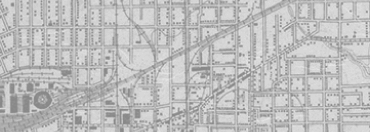


Back
Schematic diagram of the Oswald shooting
Schematic diagram of key personnel in the basement of the Dallas Municipal Building when Jack Ruby shot Lee Harvey Oswald on Sunday, November 24, 1963.The diagram is printed in black ink, but possibly was originally color-coded based on the key in the lower center of the page:"Red DetectivesGreen ReservesYellow SupervisorsPurple CiviliansBlack News Media[circle with X inside] Oswald"The diagram shows Western Union near the upper left corner, Main Street on the left side of the page, Parking Areas in the middle of the diagram, Up and Down Ramps with vehicles near the lower part of the page, the Jail Office in the lower center of the diagram, and Commerce Street on the right side of the page.Personnel and witnesses at the time of the shooting are represented by small circles with numbers inside of them; the numbers correspond to the list of personnel involved in the shooting (L2017.1.154.2). Jack Ruby is number 90 and Lee Harvey Oswald is the only circle without a number - that circle has an X in the middle of it.This object was originally part of the evidence collected by the Dallas County District Attorney’s Office and specifically prosecutors Henry Wade and Bill Alexander during the investigation leading up to the Jack Ruby trial for the murder of Lee Harvey Oswald.
Schematic diagram of the Oswald shooting
November 1963 - March 1964
Paper
10 1/4 × 11 15/16 in. (26.1 × 30.3 cm)
Loaned Courtesy the Dallas County District Attorney's Office/The Sixth Floor Museum at Dealey Plaza
L2017.1.154.1
This detailed diagram was likely provided by or prepared in consultation with Lt. Jack Revill, commander of the Internal Affairs Division of the Dallas Police Department in 1963. After the shooting of Lee Harvey Oswald, Revill and his division conducted an extensive internal investigation. Their conclusion was that the department as a whole was negligent and no one indivudal (apart from Jack Ruby) was to blame for the shooting of Oswald in police custody. - Stephen Fagin, Curator
In order to ensure its long-term care and preservation and to facilitate public access, the Dallas County District Attorney's Office placed their Jack Ruby Trial Collection (sometimes referred to as "the DA's Jack Ruby file") on long-term loan with The Sixth Floor Museum at Dealey Plaza in 2017. The Museum is working to make the entire collection accessible through this online collections database. To find out more about this collection or to access materials not yet included here, contact the Museum's Reading Room at readingroom@jfk.org. - Megan Bryant, Director of Collections & Interpretation
This item, along with materials from the DA's Ruby file (which is on loan to the Museum) and from the Museum's permanent collection, briefly appeared in a temporary display on the Museum's seventh floor in 2017. - Lindsey Richardson, Curator of Collections
Schematic diagram of the Oswald shooting
Schematic diagram of key personnel in the basement of the Dallas Municipal Building when Jack Ruby shot Lee Harvey Oswald on Sunday, November 24, 1963.The diagram is printed in black ink, but possibly was originally color-coded based on the key in the lower center of the page:"Red DetectivesGreen ReservesYellow SupervisorsPurple CiviliansBlack News Media[circle with X inside] Oswald"The diagram shows Western Union near the upper left corner, Main Street on the left side of the page, Parking Areas in the middle of the diagram, Up and Down Ramps with vehicles near the lower part of the page, the Jail Office in the lower center of the diagram, and Commerce Street on the right side of the page.Personnel and witnesses at the time of the shooting are represented by small circles with numbers inside of them; the numbers correspond to the list of personnel involved in the shooting (L2017.1.154.2). Jack Ruby is number 90 and Lee Harvey Oswald is the only circle without a number - that circle has an X in the middle of it.This object was originally part of the evidence collected by the Dallas County District Attorney’s Office and specifically prosecutors Henry Wade and Bill Alexander during the investigation leading up to the Jack Ruby trial for the murder of Lee Harvey Oswald.
Schematic diagram of the Oswald shooting
November 1963 - March 1964
Jack Ruby trial
Basement
DA's Ruby file
Ruby, Jack
Oswald, Lee Harvey
Dallas County District Attorney's Office
Dallas Municipal Building
Dallas City Hall
Dallas
Paper
10 1/4 × 11 15/16 in. (26.1 × 30.3 cm)
Loaned Courtesy the Dallas County District Attorney's Office/The Sixth Floor Museum at Dealey Plaza
L2017.1.154.1
This detailed diagram was likely provided by or prepared in consultation with Lt. Jack Revill, commander of the Internal Affairs Division of the Dallas Police Department in 1963. After the shooting of Lee Harvey Oswald, Revill and his division conducted an extensive internal investigation. Their conclusion was that the department as a whole was negligent and no one indivudal (apart from Jack Ruby) was to blame for the shooting of Oswald in police custody. - Stephen Fagin, Curator
In order to ensure its long-term care and preservation and to facilitate public access, the Dallas County District Attorney's Office placed their Jack Ruby Trial Collection (sometimes referred to as "the DA's Jack Ruby file") on long-term loan with The Sixth Floor Museum at Dealey Plaza in 2017. The Museum is working to make the entire collection accessible through this online collections database. To find out more about this collection or to access materials not yet included here, contact the Museum's Reading Room at readingroom@jfk.org. - Megan Bryant, Director of Collections & Interpretation
This item, along with materials from the DA's Ruby file (which is on loan to the Museum) and from the Museum's permanent collection, briefly appeared in a temporary display on the Museum's seventh floor in 2017. - Lindsey Richardson, Curator of Collections








